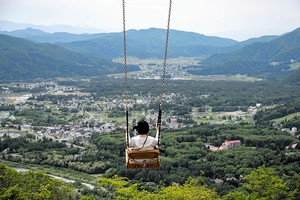THE ASAHI SHIMBUN
October 4, 2024 at 16:38 JST
A potentially catastrophic explosion of a World War II-era bomb under a taxiway at Miyazaki Airport has prompted the government to undertake an urgent search for unexploded ordnance at airports across Japan.
The search will center around the runways, taxiways and other places at several locations including Miyazaki Airport, where the incident occurred on the morning of Oct. 2, the transport ministry said.
Tetsuo Saito, the transport minister, said after the Cabinet meeting on Oct. 4 that he ordered the ministry to conduct the urgent inspections.
According to the transport ministry, it will conduct the survey using magnetic exploration during times when it doesn't interrupt operations at Miyazaki Airport starting after Oct. 7.
The ministry will also examine Sendai, Fukuoka and Naha airports, which formerly served as air bases for the imperial Japanese military during the war, where undetonated bombs were found in the past.
The ministry will leave the decision on conducting inspections at airports nationwide to the local governments that administer them.
At Miyazaki Airport, the transport ministry said a U.S.-made bomb weighing about 250 kilograms exploded at the airport just before 8 a.m. on Oct. 2.
The taxiway on the east side of the airport was damaged with the explosion leaving an oval-shaped crater about 7 meters long, 4 meters wide and 1 meter deep. There were no injuries and 87 flights were canceled while repair work was done.
The transport ministry’s airport technology division said that magnetic exploration surveys were conducted prior to building runways and taxiways if the construction sites had come under bombardment or undetonated ordnance were found there during construction.
An inspection had already been conducted at Miyazaki Airport because it served as a former Imperial Japanese Navy air base site and was subjected to aerial attacks during the war.
RELICS OF WAR THAT NEVER ENDED
Even 80 years after the war's end, live bombs from the conflict continue to be found across Japan.
On Oct. 3, the Ground Self-Defense Force removed an undetonated bomb found at Naha Airport.
The number of undetonated ordnance that the Ground SDF removed nationwide from fiscal 1972 through 2022 was 117,856 with a total weight of 4,487 tons.
The SDF has removed dangerous ordnance more than 1,000 times every year during the past five years, and for fiscal 2023, the number reached 2,348.
The Ground SDF first defuses the explosive device before removing it from the site. The process is fraught with danger.
During the work, neighboring residents are ordered to evacuate and traffic near the site is halted in many cases.
In 2013, 1,150 nearby residents in Tokyo’s Shinagawa Ward and 3,300 neighboring residents in Nagoya in 2019 were instructed to took refuge during removal of undetonated ordnance.
In addition, in July 2022 when an unexploded bomb was found in Suita, Osaka Prefecture, the JR Kyoto Line suspended operations between Osaka and Takatsuki.
The largest number has been found in Okinawa Prefecture, where the largest ground battle took place during the war.
Since the prefecture returned to Japanese control in 1972, about 40,000 undetonated ordnances have been found.
In 1974, when a land mine exploded at a construction site near a kindergarten in Naha, four people died including a 3-year-old girl and 34 others were injured.
More than 1,800 tons of live ordnance are believed to remain underground in the prefecture.
“It takes more than 70 years to completely remove them. Those are the symbols of the war that has never ended,” a senior SDF official said.
Dangerous wartime relics were discovered at Nagoya Airport in 1997, at Sendai Airport in 2012 and at Naha Airport in 2020.
Particularly at Naha Airport, a total of seven undetonated bombs or similar devices have been found this year so far.
All three airports came under attack from U.S. and British forces during the war.
(This article was written by Yuji Masuyama, Daisuke Yajima and Satsuki Tanahashi.)




















A peek through the music industry’s curtain at the producers who harnessed social media to help their idols go global.
A series based on diplomatic documents declassified by Japan’s Foreign Ministry
Here is a collection of first-hand accounts by “hibakusha” atomic bomb survivors.
Cooking experts, chefs and others involved in the field of food introduce their special recipes intertwined with their paths in life.
A series about Japanese-Americans and their memories of World War II